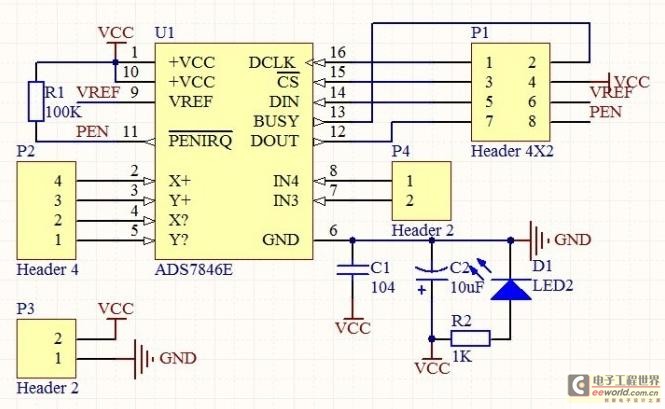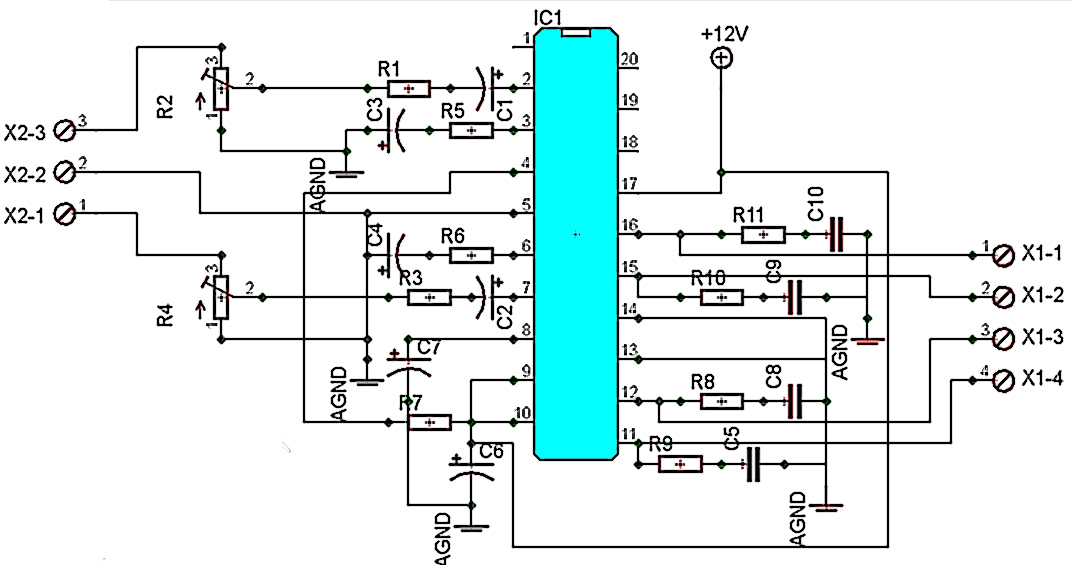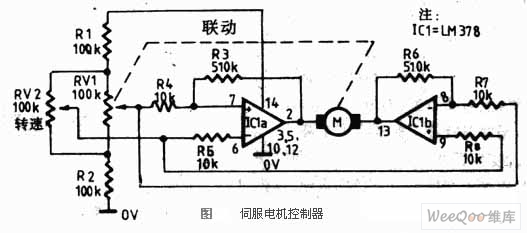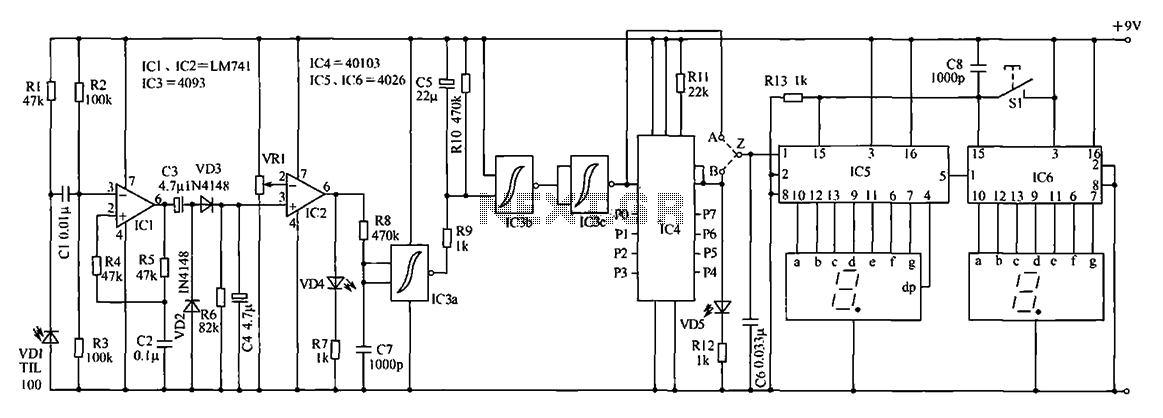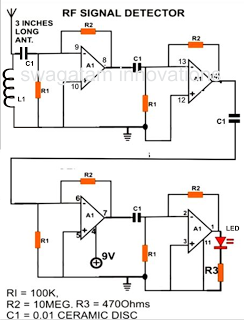
Midnight Security Light Circuit Schematic
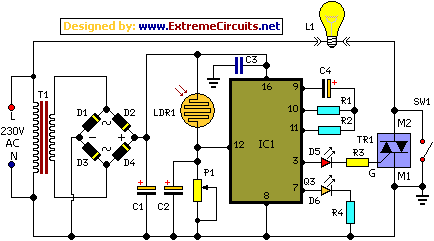
Most thefts occur after midnight when individuals enter the second phase of sleep known as paradoxical sleep. An energy-saving circuit has been designed to deter thieves by illuminating potential entry points, such as the kitchen or backyard, around 1:00 AM. This circuit automatically resets in the morning. It operates fully automatically using a CMOS IC, specifically the CD4060, to achieve the desired time delay. A light-dependent resistor (LDR1) controls the reset pin (pin 12) of IC1 to facilitate this automatic function. During the daytime, the low resistance of LDR1 keeps pin 12 of IC1 high, preventing oscillation. After sunset, the high resistance of LDR1 pulls pin 12 low, initiating oscillation, which is indicated by the flashing of LED2 connected to pin 7 of IC1. The values of the oscillator components—resistors R1 and R2 and capacitor C4—are selected so that output pin 3 of IC1 goes high approximately seven hours later, around 1 AM. This high output triggers triac 1 (BT136) through diode D5 and resistor R3. The bulb (L1), connected between the phase line and the M2 terminal of triac 1, illuminates when the gate of triac 1 receives the trigger voltage from pin 3 of IC1. It remains illuminated until pin 12 of IC1 goes high again in the morning. Capacitors C1 and C3 serve as power reserves, allowing IC1 to continue oscillating even during brief power interruptions. Capacitor C2 keeps trigger pin 12 of IC1 high during the day, ensuring that minor changes in light intensity do not affect the circuit's operation. The sensitivity of LDR1 can be adjusted using preset P1. The circuit is powered by a step-down transformer (T1) with a primary of 230V AC and a secondary output of 0-9V at 300mA, which is rectified by a full-wave rectifier made up of diodes D1 through D4 and filtered by capacitor C1. The circuit should be assembled on a general-purpose PCB with sufficient spacing between components, and the exposed leads should be sleeved. A manual switch (S1) can be used to turn the lamp on or off. The entire unit should be enclosed in a plastic case and mounted in a location that receives adequate daylight.
The energy-saving circuit described operates as a security measure by leveraging the natural light cycle to determine its activation time. The CD4060 IC serves as the core timing mechanism, utilizing its oscillator capabilities to manage the delay before activating the light source. The light-dependent resistor (LDR1) is critical for sensing ambient light levels; its characteristics allow the circuit to distinguish between day and night conditions.
During daylight, LDR1's low resistance keeps the reset pin of the IC high, effectively disabling the oscillator. As dusk falls, the resistance of LDR1 increases, causing the reset pin to go low and enabling the oscillator function. This results in a timed output that triggers the triac, which in turn controls the power to the light bulb.
The choice of components such as resistors R1 and R2, and capacitor C4, is crucial in determining the timing of the output signal. The design ensures that the light activates at a predetermined time, enhancing security during vulnerable hours. The use of capacitors C1 and C3 as power reserves is a thoughtful addition, allowing the circuit to maintain operation during minor power fluctuations.
The inclusion of a manual switch (S1) provides flexibility, allowing users to override the automatic function when necessary. Proper assembly practices, such as adequate spacing and lead sleeving, enhance the reliability and safety of the circuit. The enclosure should be designed to protect the internal components while allowing the LDR to receive sufficient light for accurate operation. Overall, this circuit represents a practical solution for enhancing home security during late-night hours, utilizing simple yet effective electronic components.Most thefts happen after midnight hours when people enter the second phase of sleep called paradoxical` sleep. Here is an energy-saving circuit that causes the thieves to abort the theft attempt by lighting up the possible sites of intrusion (such as kitchen or backyard of your house) at around 1:00 am.
It automatically resets in the morning. The circuit is fully automatic and uses a CMOS IC CD 4060 to get the desired time delay. Light-dependent resistor LDR1 controls reset pin 12 of IC1 for its automatic action. During day time, the low resistance of LDR1 makes pin 12 of IC1 high, ` so it doesn`t oscillate. After sunset, the high resistance of LDR1 makes pin 12 of IC1 low` and it starts oscillating, which is indicated by the fashing of LED2 connected to pin 7 of IC1. The values of oscillator components (resistors R1 and R2 and capacitor C4) are chosen such that output pin 3 of IC1 goes high` after seven hours, i.
e. , around 1 am. This high output drives triac 1 (BT136) through D5 and R3. Bulb L1 connected between the phase line and M2 terminal of triac 1 turns on when the gate of triac 1 gets the trigger voltage from pin 3 of IC1. It remains on` until pin 12 of IC1 becomes high again in the morning. Capacitors C1 and C3 act as power reserves, so IC1 keeps oscillating even if there is power interruption for a few seconds.
Capacitor C2 keeps trigger pin 12 of IC1 high during day time, so slight changes in light intensity don`t affect the circuit. Using preset P1 you can adjust the sensitivity of LDR1. Power supply to the circuit is derived from a step-down transformer T1 (230V AC primary to 0-9V, 300mA secondary), rectifed by a full-wave rectifer comprising diodes D1 through D4 and fltered by capacitor C1.
Assemble the circuit on a general-purpose PCB with adequate spacing between the components. Sleeve the exposed leads of the components. Using switch S1 you can turn on the lamp manually. Enclose the unit in a plastic case and mount at a location that allows adequate daylight. 🔗 External reference
The energy-saving circuit described operates as a security measure by leveraging the natural light cycle to determine its activation time. The CD4060 IC serves as the core timing mechanism, utilizing its oscillator capabilities to manage the delay before activating the light source. The light-dependent resistor (LDR1) is critical for sensing ambient light levels; its characteristics allow the circuit to distinguish between day and night conditions.
During daylight, LDR1's low resistance keeps the reset pin of the IC high, effectively disabling the oscillator. As dusk falls, the resistance of LDR1 increases, causing the reset pin to go low and enabling the oscillator function. This results in a timed output that triggers the triac, which in turn controls the power to the light bulb.
The choice of components such as resistors R1 and R2, and capacitor C4, is crucial in determining the timing of the output signal. The design ensures that the light activates at a predetermined time, enhancing security during vulnerable hours. The use of capacitors C1 and C3 as power reserves is a thoughtful addition, allowing the circuit to maintain operation during minor power fluctuations.
The inclusion of a manual switch (S1) provides flexibility, allowing users to override the automatic function when necessary. Proper assembly practices, such as adequate spacing and lead sleeving, enhance the reliability and safety of the circuit. The enclosure should be designed to protect the internal components while allowing the LDR to receive sufficient light for accurate operation. Overall, this circuit represents a practical solution for enhancing home security during late-night hours, utilizing simple yet effective electronic components.Most thefts happen after midnight hours when people enter the second phase of sleep called paradoxical` sleep. Here is an energy-saving circuit that causes the thieves to abort the theft attempt by lighting up the possible sites of intrusion (such as kitchen or backyard of your house) at around 1:00 am.
It automatically resets in the morning. The circuit is fully automatic and uses a CMOS IC CD 4060 to get the desired time delay. Light-dependent resistor LDR1 controls reset pin 12 of IC1 for its automatic action. During day time, the low resistance of LDR1 makes pin 12 of IC1 high, ` so it doesn`t oscillate. After sunset, the high resistance of LDR1 makes pin 12 of IC1 low` and it starts oscillating, which is indicated by the fashing of LED2 connected to pin 7 of IC1. The values of oscillator components (resistors R1 and R2 and capacitor C4) are chosen such that output pin 3 of IC1 goes high` after seven hours, i.
e. , around 1 am. This high output drives triac 1 (BT136) through D5 and R3. Bulb L1 connected between the phase line and M2 terminal of triac 1 turns on when the gate of triac 1 gets the trigger voltage from pin 3 of IC1. It remains on` until pin 12 of IC1 becomes high again in the morning. Capacitors C1 and C3 act as power reserves, so IC1 keeps oscillating even if there is power interruption for a few seconds.
Capacitor C2 keeps trigger pin 12 of IC1 high during day time, so slight changes in light intensity don`t affect the circuit. Using preset P1 you can adjust the sensitivity of LDR1. Power supply to the circuit is derived from a step-down transformer T1 (230V AC primary to 0-9V, 300mA secondary), rectifed by a full-wave rectifer comprising diodes D1 through D4 and fltered by capacitor C1.
Assemble the circuit on a general-purpose PCB with adequate spacing between the components. Sleeve the exposed leads of the components. Using switch S1 you can turn on the lamp manually. Enclose the unit in a plastic case and mount at a location that allows adequate daylight. 🔗 External reference
Warning: include(partials/cookie-banner.php): Failed to open stream: Permission denied in /var/www/html/nextgr/view-circuit.php on line 713
Warning: include(): Failed opening 'partials/cookie-banner.php' for inclusion (include_path='.:/usr/share/php') in /var/www/html/nextgr/view-circuit.php on line 713
